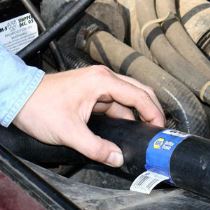Water Inlet Connector
My new motorhome came with a pressure regulator to limit the water pressure in the plumbing. But if the regulator is attached to the water inlet, I cannot close the compartment door.
If I put the regulator on the other end of the hose, I risk leaving it attached to the water faucet at the campground. I solved this dilemma by making a short (10 inches) connector hose out of a piece of 3/4-inch (inside diameter) clear vinyl hose with a fitting at each end. Be sure the fittings are made to connect to a garden hose and not a water pipe. The connector hose is flexible enough that the compartment door can close, and it’s short enough that the regulator can be kept in the compartment.
Frank S. Winter, F114882
Manalapan, New Jersey
Editor’s Note: The connector hose should be made from a reinforced, pressure-rated hose.
Here’s a simple way to keep a 1-gallon jug from tipping over and rolling around the next time you’re traveling in your motorhome. We put the dog’s water jug inside a spare dog dish and leave it under the table. I found dog dishes at IKEA for 99 cents each.
Danny Lindstrom, F310275
Salinas, California
Reducing Service Errors
Here’s a handy tip for those who take their motorhome to others for service “” or those who do their own work, but whose memories are not what they used to be. Place three labels with exact service information in the engine area. These labels help whoever is performing the service to add the right type and amount of fluid.
One label would read: “Oil Capacity Including Oil Filter XX Quarts.” The “XX” would indicate the number of quarts required for an oil and filter change. This label would be placed near your oil fill.
The second label would be for those who use TranSynd automatic transmission fluid in their Allison transmissions and would read “TranSynd ONLY.” This label would be placed near the transmission fill. Listing the fluid capacity with filter(s) change (NOT initial fill capacity) also would be a good idea.
Third, if a coolant other than standard (low-silicate coolant for diesel engines with a supplemental coolant additive) is used, place a label identifying the type of coolant/additive near the fill for the coolant reservoir. The chassis manufacturer should be able to tell you the exact coolant that was used in your motorhome, so contact them rather than taking a chance on mixing two different coolant chemistries.
Brett Wolfe, F252125
League City, Texas
{loadpositionEndBlurbTips}

